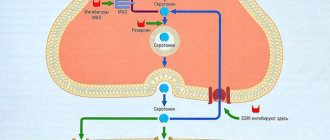Emotions control a person more than it seems at first glance. Even the absence of emotions is an emotion, or rather a whole state, which is characterized by its own characteristics in human behavior.
Emotional states are mental states that arise in the process of a subject’s life and determine not only the level of information and energy exchange, but also the direction of behavior.
Why is it so important to recognize your emotional state and that of others? It’s simple: the direction of thoughts, thinking capabilities, behavior, level of aggression, motivation, and sociability depend on it.
If you don't understand your emotional state, you won't be able to influence it if it becomes destructive. You will probably try to drown it out with external solutions such as alcohol, cigarettes, shopping or food - but all this will ultimately not help and will affect both your health and psyche.
If you do not know how to recognize the emotional state of your interlocutor, this can lead to conflicts. This has happened to everyone: you seem to be talking to a person as usual, but you are greeted with aggression. Therefore, we will divide the article into two parts. In the first, you will receive tips on how to recognize your own emotional state, and in the other, how to understand someone else’s.
General characteristics of methods for assessing emotional states
As a rule, methods for studying emotional reactions are:
- Observation
- Questionnaire
- Questioning
- Game methods (for children)
- Art therapy methods (suitable for both children and adults. Art therapy is a unique and fairly simple technique. In addition, its results are quite accurate. The principle of its action is projection, that is, in fact, subjects can unconsciously depict this or that problem, which a specialist will help decipher).
An instant test that will determine your real emotional state
An instant test that will determine your real emotional state. Today, there are many techniques that experienced recruiters and managers use to determine the personality type of their employees and establish effective communication links. Just a few decades ago, they were complex and time-consuming, but they made it possible to gain a good understanding of a person’s character.
the Luscher test turned out to be interesting, fast and accurate , and it can be used outside the office. The first one is color. It gives an idea of what a person is gravitating towards at the moment, depending on his mood and well-being. The second involves analyzing the current psycho-emotional state based on the choice of objects of one form or another and identifying key character traits.
So, we suggest you choose one of these delicious cookies. Please note: look at the illustration for no longer than 10 seconds. After this, you can proceed to interpreting the results.
An instant test that will determine your real emotional state.
Round and brown
The circle is usually chosen by sociable and peace-loving people. They gladly take part in resolving the personal conflicts of others and are ready to do anything to make everyone around them happy. They also often cross the line between public and private interests, although they do this not out of malice. Brown color shows a person's positive perception of his own physical condition. That is, the person who chooses these cookies feels quite good and is not distracted by health problems.
Assessment of emotional expressions includes three levels:
- adaptive-mobilizing (detection of changes in state parameters at the physiological level),
- behavioral-expressive (tracking external expressions of states in facial expressions, behavior, voice),
- subjective-evaluative (the subject orally or in writing expresses a subjective assessment of his experiences based on his own perception and analysis).
Diagnosis of emotional manifestations usually occurs in three directions:
- The study of conscious components of the emotional state, expressed in subjective experiences.
- The study of expressive components of the state, manifested in behavior, speech, pantomime, and products of activity.
- Study of unconscious manifestations reflected in vegetative changes in the body.
Your psychologist. The work of a psychologist at school.
The “Self-Assessment of Emotional States” technique is a questionnaire developed by American psychologists A. Wessman and D. Ricks and intended for self-assessment of a person’s well-being and emotional state at the time of examination [Big Encyclopedia of Psychological Tests / comp. A. Karelin. – M.: Eksmo Publishing House, 2006. – 416 p.]. The questionnaire consists of four blocks of statements (scales). Each scale includes 10 statements. The scale statements are arranged in descending order, from the pole of a positive emotional state (10 points) to the pole of a negative emotional state (1 point). The subject is asked to rate his emotional state by selecting the appropriate statement. The serial number of the statement corresponds to the number of points scored on the scale. Questionnaire scales: “Calmness - anxiety”, “Energy - fatigue”, “Elation - depression”, “Feeling of self-confidence - feeling of helplessness”. There are no significant data on the procedure for developing and standardizing the methodology.Instructions: Choose from each of the proposed sets of judgments the one that best describes your state now. Circle the number of the judgment selected from each set. List of statements by scale:
I. “Calmness - anxiety” 10. Perfect and complete calmness. Unshakably confident in himself. 9. Extremely calm, extremely confident and not worried. 8. Feeling of complete well-being. I am confident and at ease. 7. Generally confident and free from anxiety. 6. Nothing particularly bothers me. I feel more or less at ease. 5. Somewhat preoccupied, feeling constrained, a little anxious. 4. I am experiencing some concern, fear, anxiety or uncertainty. Nervous, worried, irritated. 3. Significant uncertainty. Quite traumatized by uncertainty. Scary. 2. Tremendous anxiety and concern. Plagued by fear. 1. Completely mad with fear. Lost my mind. Frightened by insoluble difficulties.
II. “Energy - fatigue”10. An impulse that knows no barriers. Life force overflows. 9. Overflowing vitality, enormous energy, a strong desire for activity. 8. Lots of energy, strong need for action. 7. I feel very fresh and have a lot of energy left. 6. I feel quite fresh, moderately cheerful. 5. Slightly tired. Laziness. There is not enough energy. 4. Quite tired. Apathetic (sleepy). There is not much energy left. 3. Great fatigue. Lethargic. Scarce energy resources. 2. Terribly tired. Almost exhausted and practically incapable of action. There are almost no energy reserves left. 1. Absolutely exhausted. Incapable of even the slightest effort.
III. “Elation - depression” 10. Strong enthusiasm, enthusiastic joy. 9. Very excited and in a very high state. Enthusiasm. 8. Excited, in a good mood. 7. I feel very good. Cheerful. 6. I feel pretty good, okay. 5. I feel a little depressed, so-so. 4. The mood is depressed and somewhat sad. 3. Depressed and feeling very depressed. The mood is definitely gloomy. 2. Very depressed. I feel absolutely terrible. 1. Extreme depression and despondency. Depressed. Everything is black and gray.
IV. “A feeling of self-confidence is a feeling of helplessness” 10. Nothing is impossible for me. I can do whatever I want. 9. I feel more confident in myself. Confident in my achievements. 8. Very confident in your abilities. 7. I feel that my abilities are sufficient and my prospects are good. 6. I feel quite competent. 5. I feel that my skills and abilities are somewhat limited. 4. Feeling pretty incapable. 3. Depressed by his weakness and lack of abilities. 2. I feel pathetic and unhappy. Tired of my incompetence. 1. A pressing feeling of weakness and futility of efforts. I can't do anything.
Processing and interpretation of results Measurement in the method is carried out using a 10-point (wall) system. In general, the higher the selected score, the closer the subject's condition is to the positive pole of each scale (and vice versa). The following indicators are measured: P1 (indicator) - C (self-esteem) “Calmness - anxiety” (individual self-esteem - I1 - equals the number of the judgment selected by the subject from this scale. Individual values for indicators P2, P3, P4 are obtained in the same way); P2 - C “Energy - fatigue”; P3 - C “Elation - depression”; P4 - C “Feeling of self-confidence - feeling of helplessness”; P5 - C - total state assessment on four scales: I5 = I1 + I2 + I3 + I4, where I1, I2, I3, I4 are individual values on the corresponding scales.
Introduction
The relevance of the work may be due to the fact that recently people have become less likely to show their emotions, replacing them with emoticons on social networks. An analysis of more than 31 million messages on Twitter showed that emoticons are a common component of text. An experiment was also conducted in which participants had to communicate online. It was found that subjects considered experts who used emoticons when communicating to be more friendly and competent. In connection with the above, the relevance of the topic is beyond doubt.
The object of the course work was emotional states.
The subject of study is methods for diagnosing emotional states.
The purpose of the course work is to compare methods for studying emotional states.
The hypothesis of the study is that the relevance of emotional states is presumably associated with recognizing the emotions of other people.
Based on the object, subject, hypothesis and purpose of the course work, the following tasks were set:
1. Explore the theoretical foundations of the study of emotional states.
2. Analyze psychological methods for diagnosing emotional states.
The theoretical basis of the study is the scientific ideas and theoretical positions of such authors as Wilhelm Wundt, William James, John Watson, Carroll Izard, Sergei Leonidovich Rubinstein, Pyotr Kuzmich Anokhin, Pavel Vasilievich Simonov, Alexey Nikolaevich Leontiev, Paul Ekman, Izard Carroll.
Methods for studying emotional states: “Ekman Faces” test, “Differential Emotions Scale” technique, Spearman rank correlations, comparison, analysis, synthesis, generalization.
The practical significance of the research may lie in the fact that the information I received can be used by practicing psychologists in their scientific practice.
The role of emotions in human life
Emotional and volitional processes are mental phenomena that form the general functional state of the human psyche and control the cognitive and other processes occurring in it. They include the emotions, feelings and will of a person. Each of them has an independent physiological basis and affects mental activity in its own way.
Emotions act as an internal language, as a system of signals through which the subject learns the necessary meaning of what is happening. The peculiarity of emotions is that they directly reflect the connection between motives and the performance of activities consistent with these motives. In human activity, emotions perform the function of assessing their course and results. They organize, stimulate and direct activities.
It is noted that various objects and phenomena of the objective world influence the sphere of human consciousness in different ways - some, please, disturb him, some leave him indifferent. This is the result of a conscious reaction to them by the psyche (emotions and feelings). Consequently, emotions (Latin emoveo - shock, excitement) are understood as an integral subjective reaction of the human psyche to the action of external or internal stimuli, manifested in specific feelings (pleasure or displeasure, joy or sadness, confidence or fear, etc.). They accompany almost every manifestation of the body’s vital activity, reflect the meaning (meaning) of phenomena or situations, and serve as one of the main mechanisms of internal regulation of mental (especially cognitive) activity and behavior aimed at satisfying the actual material or spiritual needs of a person.
The consistent development of emotions in society was determined by the need for their orientation towards new socially significant phenomena, which led to the formation of the highest form of their manifestation - feelings, which represented a person’s stable emotional attitude towards the phenomena of objective reality, manifested in mentally conditioned experiences.
Consequently, feelings meet the highest social needs and express a person’s attitude towards social phenomena, other people and himself, etc. At the same time, they are characterized by stability, independence from the state of the body and a visually perceived situation. At the same time, the feelings formed become the main determining factors in a person’s emotional life, on which the appearance and content of situational sensations depend.
The simplest form of manifestation of emotions is the emotional background, which represents innate hedonic (Greek hedone - pleasure) experiences associated with certain life sensations (for example, taste, temperature, pain, etc.). Already at this level they are divided into two polar types (classes). Positive (stenotic) emotions arise from a person’s awareness of the usefulness of external or internal influences on the body and motivate him to achieve or maintain them. At the same time, negative (asthenic) emotions stimulate activity aimed at avoiding unwanted or dangerous influences, but at the same time, to some extent, consolidate mental function as a whole.
The oldest, simplest and most common form of emotional experience is pleasure, which arises as a result of satisfying organic needs, or discomfort, which is associated with the inability to do this when the corresponding need intensifies. The close relationship that exists between emotions and the activity of the body is evidenced by the fact that each emotional state is accompanied by many physiological changes in the body. Repeated attempts have been made to connect these changes with certain emotions and to prove that the complexes of organic changes accompanying various subjectively experienced emotional states are different. However, it has never been possible to unambiguously establish which of the emotional experiences provided to us are subjectively accompanied by organic changes.
This fact is necessary to understand the important role of emotions. This indicates that our subjective experience is not a direct, immediate reflection of our own organic processes. Probably, it is not so much the accompanying organic changes associated with the specifics of the emotional states that we experience, but rather the sensations that come from them. However, there is a certain interdependence between the specifics of emotional sensations and organic reactions. It is expressed in the form of the following correlation, which has been experimentally confirmed: The closer to the central nervous system is the source of organic changes associated with emotions, and the fewer sensitive nerve endings, the weaker the result of subjective emotional experience. Moreover, an artificial decrease in organic sensitivity leads to a weakening of the strength of emotional experiences.







